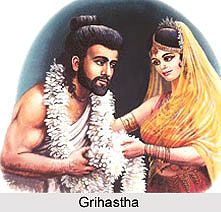 Grihastha is the second phase in an individual`s life. After Brahmacharya a man moves forward to fulfill his familial responsibilities. From 20 to 60 years of age he leads a grihastha life. According to Manu, the Hindu theologist, during the Grihastha phase one was ought to marry and execute his personal and private duties. Hence the householder`s life comprised of marrying, raising children, looking after the family and performing daily the 5 sacrifices known as Pancha Maha Yajna. It is at this stage of life that his knowledge of Brahmacharya helped him. He also needs to fulfill the social duties.
Grihastha is the second phase in an individual`s life. After Brahmacharya a man moves forward to fulfill his familial responsibilities. From 20 to 60 years of age he leads a grihastha life. According to Manu, the Hindu theologist, during the Grihastha phase one was ought to marry and execute his personal and private duties. Hence the householder`s life comprised of marrying, raising children, looking after the family and performing daily the 5 sacrifices known as Pancha Maha Yajna. It is at this stage of life that his knowledge of Brahmacharya helped him. He also needs to fulfill the social duties.
To achieve this end he needs help from his wife. Together they set out to perform their Dharmik duties. According to Hindu Sashtras Grihastha is at the core of the four stages of life. People in other three ashrams were dependent on the Grihastha for carrying out their respective duties. The life of a householder is also recognized as Jivayagna that means a lifelong saga of sacrifice for the benefit of loved ones and the society. Marriage in Hindu religion is an auspicious relation. According to the then contemporary society marriage was a means to attain spiritual glory. It leads to the development of a link between the past and present through procreation. Thus it leads to the creation of family and the progeny can carry on the traditions. According to Hindu Dharma, the Grihastha needs to follow the ` Pancha Maha Yajna
The ` Pancha Maha Yajna ` includes the following: -
Deva Yajna: Worshipping Hindu gods like Ganapathi, Kula devta and Ishta devta.
Brahma Yajna: This Yajna includes Guru worship, studying, teaching, repeating and meditating upon the Vedic scriptures by following Vedic rites. Through this the Grihastha expresses his debt to humanity by working for the society. Ethically following one`s profession was one of the ways of serving the society.
Pitru Yajna: This yajna is directed to the ancestors. Besides them, they can also be organized for parents to get their blessings by touching their feet. Children who have lost their parents should annually perform Shradhas or Thithi. This is done to keep the soul of the dead in peace. Observing fasts on the new moon days and during beginning of months and offering `pinda` to crows or holy rivers are all part of this ritual. Those who are unaware of the tithi of their parents death should perform shradha on the new moon day of the month which occurs between the second week of January and the second week of February. The fasting observed on amavasya is a way of remembering ancestors back to the 7th generation.
Bhuta Yajna: This is the worship of living beings by scattering grains, offering food to the animals, birds or insects. Caring for plants also comprise of this yajna.
Nara Yajna or Purusha Yajna: Extending hospitality to fellow human beings and treating guests with respect are included in this kind of yajna. Time and again Hinduism has stressed on love for relatives, beggars and even strangers.
According to the ancient saints marriage is an integral part of a Grihastha. It not only involves two people but two families as well. Moreover, no ritual is effective without the presence of the wife, the Sahadharmini.



















